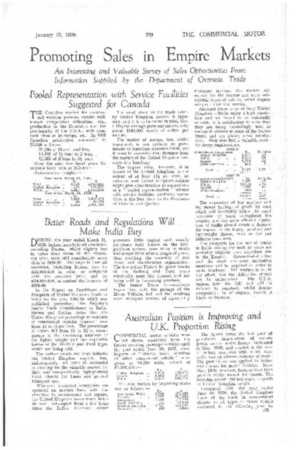Australian Position is improving and U.K. Proportion Rising C OMMERCIAL motor
Page 77

Page 78

If you've noticed an error in this article please click here to report it so we can fix it.
vehicles were not shown separately from the figures covering passenger vehicles until the year ended June 30, 1937, when imports of " chassis-truck, omnibus or other commercial vehicle " were given as 14,728 units, valued at £1,597,241
The figures cover the first year of prohibited importation of certain goods, except under licence, instituted in May, 1936, and applied in the case of certain countries with which Australia had an adverse balance of trade. The prohibition was applied to bodies and chassis for motor vehicles. Since May, 1938, however, licences have been granted freely, except for chassis. The licensing system did not apply to goods of United Kingdom origin.
Compared with the year ended June 30, 1936, the United Kingdom share of the trade in unassembled chassis for all types of motor vehicle increased in the following ,year by £800,000, the Canadian share fell by £300,000, and the U.S.A. share by about £400,000. It is to be remarked that whilst the total trade in motorcar bodies fell from £149,593 to 281,380, the United Kingdom share rose from £54,095 to £71,402 and the U.S.A. share fell from £94,431 to £8,642.
It should be borne in mind that all values are in sterling and that the corresponding values in Australian cur rency are roughly 25 per cent higher.
As against an import of 14,728 units there must be set Australian production of " chassis (including engines) assembled,' viz., 16,488 for trucks alone.
„From the figures the competitive position is apparent and it is greatly more favourable to the United Kingdom motor-vehicle industry than in, for invtance, the Canadian market. and improvement, and declared so many thousands of miles of roads to be national roads. In some cases the national roads followed exactly the track of previously existing roads, whilst in other cases roads were to be rerouted.
The National Road Board is a planning and controlling body to which the Union Government assigns funds to be spent on national roads. The actual work of construction and maintenance remains in the hands of the provincial authorities which were in charge of roads before the advent of the National Road Board. The original five years' plan of 1935, which has perhaps not progressed as rapidly as was expected, has since been expanded and is likely to require several more years for its execution,
The Union is to he regarded as a market which fully justifies a forward policy on the part of United Kingdom manufacturers of commercial motor ,-e.h icles.




















































































































































